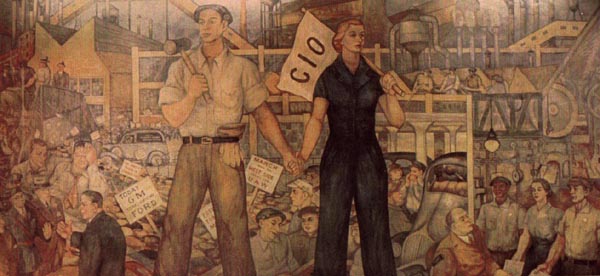
"Saving a Piece
of Labor History"
by Jim Burton

The Great Depression in the United States lasting from the end of 1929 until the early 1940s was the worst and longest economic collapse in the history of the modern industrial world. The depression produced lasting effects on the United States that are still apparent more than half a century after it ended.
The depression led to the election of President Franklin Delano Roosevelt, who created programs known as the New Deal to overcome the effects of the Great Depression. These programs expanded government intervention into new areas of social and economic concerns and created social-assistance measures on the national level. The Great Depression changed the relationship between the government and the people, who came to expect and accept a larger federal role in their lives and the economy.
The programs of the New Deal also brought together a new, liberal political alliance in the United States. Roosevelt's policies won the support of labor unions, blacks, people who received government relief, ethnic and religious minorities, intellectuals, and some farmers, forming a coalition that would be the backbone of the Democratic Party for decades to come.
On May 6, 1935 the Works Progress Administration (W.P.A.) was created to help provide economic relief to the citizens of the United States who were suffering through the Great Depression. The artistic community had already become inspired during the 1920s and '30s by the revitalization of the Italian Renaissance fresco style by the inspired creations of Mexican muralists Diego Rivera, Jose Clemente Orozco, and David Alfaro Siqueriros. Certain visionary U.S. politicians decided to combine the creativity of the new art movements with the values of the American People. The Federal Art Project was one of the divisions of the W.P.A. created under Federal Project One. President Franklin D. Roosevelt had made several attempts prior to the F.A.P. to provide employment for artists on relief, namely the Public Works of Art Project (P.W.A.P.), which operated from 1933 to 1934, and the Treasury Department Section of Painting and Sculpture, which was created in 1934 after the demise of the P.W.A.P. However, it was the F.A.P., which provided the widest reach, creating over 5,000 jobs for artists and producing over 225,000 works of art for the American people.
In 1937 an artist named Walter Speck completed a mural in the union headquarters of the West Side Local 174, UAW that was located in the city of Detroit. Speck, who was versed in ceramic pottery and fine arts, was born in Detroit, Michigan on December 29th 1895. He was head of the Works Progress Administration (W.P.A.) arts program in Detroit, Michigan.
With this merger came a new name "The West Side Local 174." The local number remained 174 in honor of the first West Side Local 174 President Walter P. Reuther. Thanks to UAW Local 157 President Bruno Duchaine and now the first President of The West Side Local 174 and Local 174 retiree Mike Kerwin and the membership we were able keep the legacy of Walter P. Reuther.
Over the years this priceless piece of labor art has seen it's fair share of cigarette smoke, water damage and sad to say, vandalism. We started raising funds for the mural in June of 2002 and will continue until the mural is fully restored. The mural can be viewed at The West Side Local 174 hall located at 29841 Van Born in Romulus, Michigan. Please call the local to make sure that someone is available to show the mural. 734-728-7600
Donations can be sent
to:
The West Side Local 174
UAW
29841 Van Born Road
Romulus, Michigan 48174
Mural Restoration Fund
Copyright 2005 Nancy Lorance
All Rights Reserved.